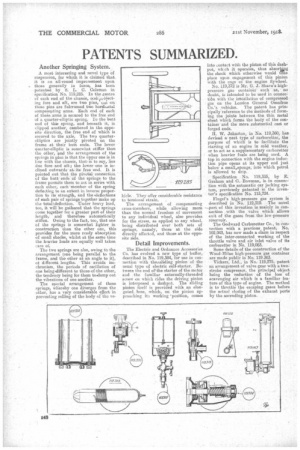PATENTS SUMMARIZED.
Page 22

If you've noticed an error in this article please click here to report it so we can fix it.
Another Springing System.
A most interesting and novel type of suspension, for which it is dein:led that it is on all-round improvement upon those generally in force' has been patented by S. L. C. Coleman in specification No. 119,285. In the centre of each end of the -chassis, and4ibiecting fore and aft, are two pins, -Loa on these pins are fulcrumed two horffieital compensating arms. Each end of each of tilde:, arms is secured to the free end of a quarter-elliptic spring. To the butt end of this spring, and beneath it, is dipped another, cambered in tha opposite direction, the free end of which is secured to the axle. The two quarterelliptics are jointly pivoted on the frame at their butt ends. The lower quartor-elliptic is somewhat stiffer than the other, and the arrangement of the springs in plan is that the upper one is in line with the chassis, that is to say, lies i due fore and aft; the lower -one s inclined outwards at its free end. It is pointed out that the pivotal conneetitin of the butt ends of the springs to the frame permits them to act in series with. each other, each member of the spring detecting to an extent in inverse proportion to its strength, and the 'deflections of each pair of springs together make up the totalt.deflection. Under heavy load, too, it will be gathered that the springs come together for a greater part of their length, and therefove automatically stiffen. Owing to the fact, too that one of the springs is somewhat lighter in construction than the other one, this provides for the more ready absorption of small shocks, whilst at the same time the heavier loads are equally well taken care of.
The two springs are also, owing to the arrangement (one being parallel to the frame, and the other at an angle to it), ot different lengths, This avoids isochronism, the periods of oscillation of one being.different to those-of the other, the tendency being for them toelamp out the vibrations of one another.
The special arrangement of these springs, whereby one diverges from the other, has a very considerable effect in preventing rolling of the body of the ye hide. They offer considerable resistance to torsional strain.
The arrangement of compensating cross-members, while allowing more than the normal freedom of movement to any individual wheel, also provides for the stress, as applied to any wheel, being distributed over both sets of springs, namely, those at the side directly affected; and those at the opposite side.
Detail Improvements.
The Electric and Ordnance Accessories Co. has evolved a new type of buffer, described in No. 119,384, for uso in connection with theasliding pinion of the usual type of electric self-starter. Between the end of'the starter of the motor and the familiar externally-threaded screw on which rides the driving pinion is interposed a dashpot. The sliding pinion itself is provided with an elongated boss, which, on the pinion approaching its working •position, comes into contact with the piston of this dashpot, wh:ch it, operates, thus absortipg the shock which otherwise would tYge place upon engagement of this pinion with the cogs of the engine flywheel. No. 119,372 is Mr. G. J. Shave's highpressure gas container such as, no doubt, is intended to be used in connectiAn with the intallation of compressed gas on the London General Omnibus Co.'s vehicles. The patent has principally reference to the methods of forming the joints between the thin metal sheet which forms the body of the container and the more substantial east or forged ends.
H. W. Johnston, in N. 119,360, has devised a neat type of carburetter, the purpose of which is to facilitate the starting of an engine in cold weather, or to act as a supplementary carburetter when heavier fuels are bemg used. A tap in connection with the engine induction pipe opens at its upper end just below a smalLsponge, into which petrol is allowed to drip.
Specification No. 119,335, by E. Graham and G. Bowman, is in connection with the automatic car jacking system, previously patented in the inventor's specification No. 115,724.
Flugel's high-pressure gas system is described in No. 119,319. The novel --part of this invention is mainly in connection . with the valve which allows exit of the gases from the low-pressure reservoir.
The Godward Carburetter Co., in con• nection with a previous patent, No. 102,043, has now made a claim in respect of the inter-connected working of the throttle valve and air inlet valve of its carburetter in No. 119,063.
Some detailaof the construction of the Wood-Milne high-pressure gas container • are made public in No. 119.303. Vickers, Ltd., in No. 119,275, patent an arrangement of valve gear with a twostroke compressor, the principal object being the reduction of the lose of scavenging air which is a familiar feature of this type of engine. The method is to throttle the escaping gases before the actual closing of the exhaust ports by the ascending piston.






















